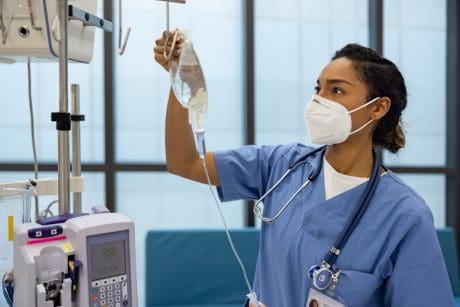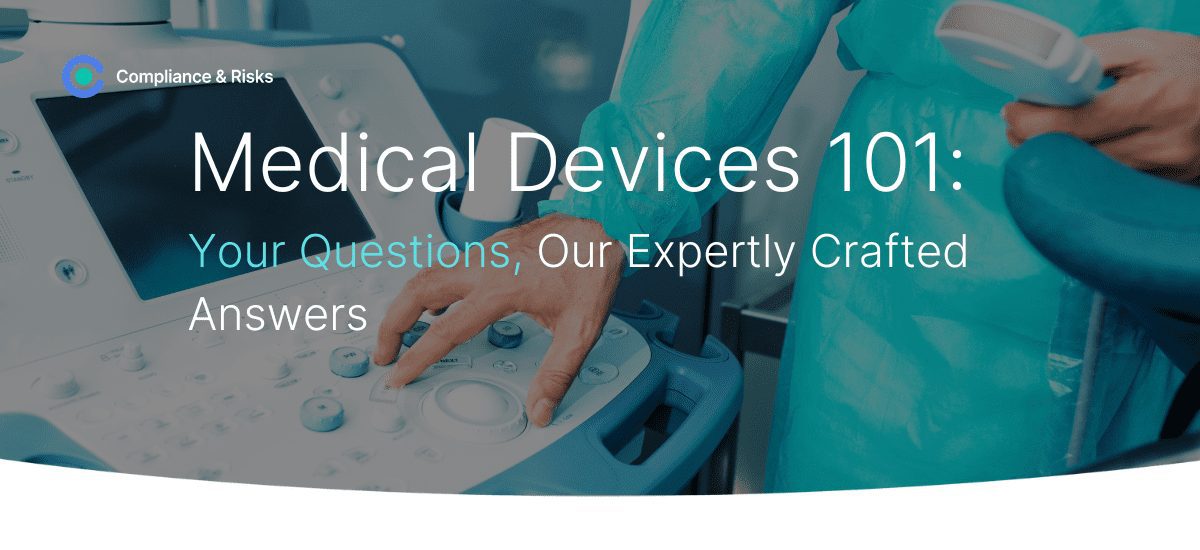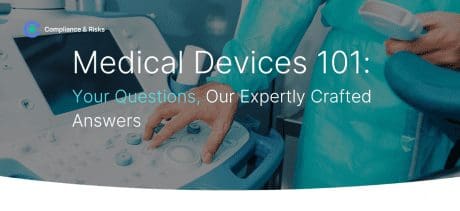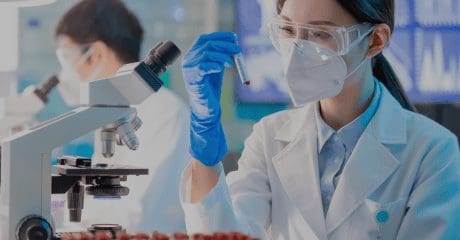
Medical Devices 101 | Your Questions | July 2023

Medical devices face a unique regulatory landscape that has been increasingly complicated by several factors in recent years.
The demand for more sustainable technology is being driven by both consumer demand and legislators, leading to regulatory implications. Global events such as Brexit and COVID-19 have also created unprecedented challenges.
As devices become increasingly integrated with artificial intelligence and an internet connection, new cybersecurity and data protection legislation is racing to keep up.
And on top of all this, the new regulatory framework for IVDR and proposed amendments for the registration, and inspection of medical devices under MDR means staying ahead is more critical than ever.
In our new series, we gather some of the most interesting recent inquiries from Compliance & Risks customers regarding the medical device regulatory updates globally:
Question 1: Regarding the Regulation Concerning Safety of Chemical Products in the Russian Federation, is there any additional information available currently such as exemptions, data requirements, existing register etc?
Dieudonne Ymedji , Senior Regulatory Compliance Specialist answers:
This draft resolution aims to approve the Russian Federation technical regulation (TR) on the safety of chemicals products (i.e new chemical substance or a mixture containing new chemical substances not yet notified in the registry of chemical substances and mixtures) put into circulation into the country.
Only polymers appear to be excluded from the notification scope. The notification requirements as well as the rules on the functioning of the registry of chemical substances are appended to the draft proposal.
Additionally, there are variable deadlines for the registration or notification of chemical substances and mixtures newly placed into the Russian federal market. For new substances manufactured or imported:
- between 100 to 1000 t/year: the obligation to notify takes effect after 1 year from the date of entry into force of the TR;
- between 1 to 100 t/y: 24 months;
- in quantities of less than 1 t/y: 36 months
The notification obligation applies 48 months after the entry into force of the TR for mixtures put into circulation in Russia market in quantities of more than 1000 t/y and 60 months for mixtures manufactured/imported in amount less than or equal to 1000 t/y.
Question 2: Do Canada and the UK typically implement updates to POPs Stockholm Convention in a timeframe similar to EU POPs updates?
Dieudonne Ymedji , Senior Regulatory Compliance Specialist answers:
Canada is among the 1st countries that ratified the Stockholm Convention. The Prohibition of Certain Toxic Substances Regulations, 2012, the PCB Regulations, 2008, and the Pest Control Products Act, prohibit the production and use of several POPs. For further alignment with recent amendments to the Stockholm Convention, a proposed regulation to repeal and replace the 2012 one is under consideration since May 2022. The proposal introduces new prohibitions on the manufacture, use, sales and import of Dechlorane Plus and DBDPE, as well as products containing these substances. It also further restricts the manufacture, use, sale and import of PFOS, PFOA, LC-PFCAs, HBCDD and PBDEs, as well as products containing these substances, by cancelling certain exemptions or restricting activities permitted under existing regulations.
The current UK POPs legislation is the same as the EU. However, since BREXIT, any changes made to the Stockholm Convention are considered by the UK government before changing the UK’s legislation. In this regard, a consultation on proposals to amend the UK’s POPs legislation in order to align with the recent additions or amendments to the UN’s Stockholm Convention on POPs was concluded on 27 April 2023
Question 3: Regarding Vermont (USA): Regulating Products containing Certain Chemicals and Chemical Classes (including PFAS), House Bill 152, January 2023, does Prohibiting PFAS in All Products Effective July 1, 2030 include medical devices and IVDs or pharmaceutical products and food/ food packaging?
Victoria Smart, Senior Regulatory Compliance Specialist answers:
This section of the bill, which proposes to prohibit “any product” containing PFAS, would apply to any product, including medical devices or IVDs unless exempted by law or regulation. The text of this prohibition, below, does create the prospect of an agency establishing by rule an exemption, in this case a specific exemption, for PFAS in a product or product category as an “unavoidable use”:
“§ 1698. PROHIBITION ON PRODUCTS CONTAINING PFAS 5 Unless otherwise required by federal law, a manufacturer, supplier, or distributor shall not manufacture, sell, offer for sale, distribute for sale, or distribute for use in this State any product that contains intentionally added PFAS, unless the Department has determined by rule pursuant to 3 V.S.A. chapter 25 that the use of PFAS in a product is currently an unavoidable use. The Department may specify by rule specific products or product categories in which it has determined that the use of PFAS is currently an unavoidable use. This prohibition does not apply to the sale or resale of used products”
Pharmaceuticals and food are not regulated by the federal TSCA, as it eschews overlap with the FDA. Vermont may choose to follow that but does not appear to be required to do so, unless a federal law or rule intercedes.
Question 4: Regarding the EU Opinion document on Annex XV Dossier Proposing Restrictions on Undecafluorohexanoic acid (PFHxA), its salts and Related Substances under REACH, ECHA RAC/SEAC, did it propose that IVDs should be included in the medical device derogation. Has this been confirmed?
Dieudonne Ymedji , Senior Regulatory Compliance Specialist answers:
The SEAC final opinion (available for download in C2P) adopted on December 2021, recommends a broad derogation with a transitory period of 12 years, for in vitro diagnostic medical devices, falling under the IVD MD Regulation 2017/746 and medical devices, woven, knitted and nonwoven medical textiles as specified in Regulation (EU) 2017/745.
Stay Compliant With Global Medical Device Regulations:
Catch up on our medical device updates with your coffee here:
- Regulatory Trends in Medical Devices: A 12-18 Month Outlook
- A Comprehensive Guide to Medical Device Regulation in Israel: Registration, Documentation, and Labeling Requirements
- Recent Updates to Medical Device Regulation in Great Britain
- IVDR Compliance: What You Need To Know
Register for our on-demand webinar for a regulatory update on the medical devices industry here.
Have you got a Medical Device related query?
Many of the above questions were submitted and answers were conveyed by Compliance & Risks customers via the “Ask Our Experts” button in C2P.
Clients use AOE to ask about the latest proposed, enacted, and amended regulations and mandatory standards applicable to their products and geographies of interest.
When AOE questions can be answered in 30 minutes or less, Compliance & Risks’ subject matter experts answer them at no charge!
To learn more about C2P and how Compliance & Risks SMEs can help you with your questions, contact us today.
Meet our Expert

Dieudonne Ymedji, Senior Compliance Specialist, Compliance & Risks
Dieudonne is a regulatory professional with wide-ranging experience in researching and assessing global environmental and product safety regulations impacting products.
He has expereince in serveral areas including chemicals, materials and substances. Dieudonne specifically tracks and monitors EU REACH-type regulations across the world such as K-REACH, China REACH, Japanese Chemical Substances Control Law (CSCL), Turkey KKDIK and regulatory areas of nanotechnology; e-waste, packaging; product safety; RoHS; trade and export controls.


